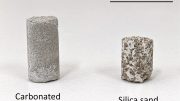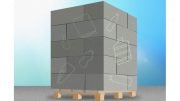
Concept artwork depicting a new metamaterial concrete in use on a highway. Credit: Amir Alavi via Midjourney
Scientists develop self-monitoring metamaterial concrete for smart infrastructure systems.
Engineers at the University of Pittsburgh are bringing concrete into the 21st century by reimagining its design. Concrete, which has its roots dating back to the Roman Empire, remains the most widely utilized material in the construction industry.
A new study presents a concept for the development of smart civil infrastructure systems with the introduction of metamaterial concrete. The research presents a concept for lightweight and mechanically-tunable concrete systems with integrated energy harvesting and sensing capabilities.
“Modern society has been using concrete in construction for hundreds of years, following its original creation by the ancient Romans,” said Amir Alavi, assistant professor of civil and environmental engineering at Pitt, who is the corresponding author on the study. “Massive use of concrete in our infrastructure projects implies the need for developing a new generation of concrete materials that are more economical and environmentally sustainable, yet offer advanced functionalities. We believe that we can achieve all of these goals by introducing a metamaterial paradigm into the development of construction materials.”
Alavi and his team have previously developed self-aware metamaterials and explored their use in applications like smart implants. This study introduces the use of metamaterials in the creation of concrete, making it possible for the material to be specifically designed for its purpose. Attributes like brittleness, flexibility, and shapeability can be fine-tuned in the creation of the material, enabling builders to use less of the material without sacrificing strength or longevity.
“This project presents the first composite metamaterial concrete with super compressibility and energy harvesting capability,” said Alavi. “Such lightweight and mechanically tunable concrete systems can open a door to the use of concrete in various applications such as shock absorbing engineered materials at airports to help slow runaway planes or seismic base isolation systems.”
Not only that, but the material is capable of generating electricity. While it cannot produce enough electricity to send power to the electrical grid, the generated signal will be more than enough to power the roadside sensors. The electrical signals self-generated by the metamaterial concrete under mechanical excitations can also be used to monitor damage inside the concrete structure or to monitor earthquakes while reducing their impact on buildings.
Eventually, these smart structures may even power chips embedded inside roads to help self-driving cars navigate on highways when GPS signals are too weak or LIDAR is not working.
The material is composed of reinforced auxetic polymer lattices embedded in a conductive cement matrix. The composite structure induces contact-electrification between the layers when triggered mechanically. The conductive cement, which is enhanced with graphite powder, serves as the electrode in the system. Experimental studies show that the material can compress up to 15% under cyclic loading and produce 330 μW of power.
Reference: “Multifunctional Nanogenerator-Integrated Metamaterial Concrete Systems for Smart Civil Infrastructure” by Kaveh Barri, Qianyun Zhang, Jake Kline, Wenyun Lu, Jianzhe Luo, Zhe Sun, Brandon E. Taylor, Steven G. Sachs, Lev Khazanovich, Zhong Lin Wang and Amir H. Alavi, 4 February 2023, Advanced Materials.
DOI: 10.1002/adma.202211027
The research team is partnering with the Pennsylvania Department of Transportation (PennDOT) through the IRISE Consortium at Pitt to develop this metamaterial concrete for use on Pennsylvania roads.
The project included researchers from Johns Hopkins University, New Mexico State University, the Georgia Institute of Technology, Beijing Institute of Nanoenergy and Nanosystems, and Pitt’s Swanson School of Engineering.









I wonder what the cost of this new magic metamaterial is going to be. As concrete is a massive bulk material, the added costs needs to be quite low…